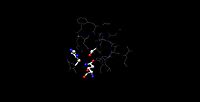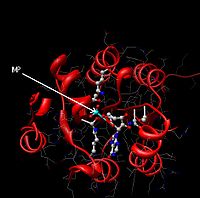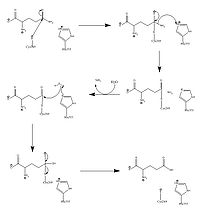
Carbamoyl phosphate synthetase I
Encyclopedia

Ligase
In biochemistry, ligase is an enzyme that can catalyse the joining of two large molecules by forming a new chemical bond, usually with accompanying hydrolysis of a small chemical group dependent to one of the larger molecules...
enzyme located in the mitochondria involved in the production of urea. Carbamoyl Phosphate Synthetase I (CPSI) transfers an ammonia
Ammonia
Ammonia is a compound of nitrogen and hydrogen with the formula . It is a colourless gas with a characteristic pungent odour. Ammonia contributes significantly to the nutritional needs of terrestrial organisms by serving as a precursor to food and fertilizers. Ammonia, either directly or...
from glutamine
Glutamine
Glutamine is one of the 20 amino acids encoded by the standard genetic code. It is not recognized as an essential amino acid but may become conditionally essential in certain situations, including intensive athletic training or certain gastrointestinal disorders...
to a molecule of bicarbonate
Bicarbonate
In inorganic chemistry, bicarbonate is an intermediate form in the deprotonation of carbonic acid...
that has been phosphorylated by a molecule of ATP. The resulting carbamate is then phosphorylated with another molecule ATP. The resulting molecule of carbamoyl phosphate
Carbamoyl phosphate
Carbamoyl phosphate is an anion of biochemical significance. In land-dwelling animals it is an intermediary metabolite participating in the nitrogen disposal through in the urea cycle and the synthesis of pyrimidines....
leaves the enzyme.
Structure of Carbamoyl Phosphate Synthetase I
CPSI is a heterodimer with a small subunit and a larger subunit with about 382 and 1073 amino acid residues in size. The small subunit contains one active site for the binding and deamination of glutamine to make ammonia and glutamate. The large subunit contains two active sites, one for the production of carboxyphosphate, and the other for the production of carbamoyl phosphate. Within the large subunit there are two domains (B and C) each with an active site of the ATP-grasp family. Connecting the two subunits is a tunnel of sorts, which directs the ammonia from the small subunit to the large subunit.


Mechanism of Carbamoyl Phosphate Synthetase I
The overall reaction that occurs in CPSI is:2ATP + HCO3- + NH4+ --> 2ADP + Carbamoyl phosphate + Pi
Pi
' is a mathematical constant that is the ratio of any circle's circumference to its diameter. is approximately equal to 3.14. Many formulae in mathematics, science, and engineering involve , which makes it one of the most important mathematical constants...
This reaction can be thought of occurring in four distinct steps.
- Bicarbonate is phosphorylated
- Ammonia is taken off glutamine
- The ammonia from glutamine attacks the carboxyphosphate, resulting in carbamate
- Carbamate is phosphorylated to give Carbamoyl phosphate
Of these four steps, only step two - the deamination of glutamine to get ammonia - is known to have actively participating amino acid residues, Cys269 and His353. The other three steps mostly utilize amino acid residue to form hydrogen bonds with substrates. A video of a simplified version of this mechanism is available here
Recent Mechanism Studies
It has been found that both ATP-binding sites in the large subunit of CPSI are structurally equivalent. A recent study has investigated the interlinking between these two domains (domain B and domain C) and has found evidence that they are coupled. This ATP-binding domain coupling works in a way such that a molecule of ATP binding at one site (domain C) conformationally allows synthesis at the other domain (domain B). If this is the case, carbamoyl phosphate is, in fact, not formed in step 5 (of the included mechanism below) by ejecting ADP but rather in step 4 by protonating the alcohol group and then kicking it off as water..

Regulation
CPSI is allosterically regulated by purine and pyrimidine nucleotides, wherein the former allosterically activates the enzyme and the later allosterically inhibits CPSI. Also, it has been found that ornithine is an allosteric activator of CPSI. Increased levels of ammonia also activate CPSI, while decreased levels of ATP inhibit CPSI activity. All allosteric binding sites are located in the large subunit of the enzyme.Carbamoyl Phosphate Synthetase I and Metabolism
CPSI plays a vital role in protein and nitrogen metabolism. Once ammonia has been brought into the mitochondria via glutamine or glutamate, it is CPSI’s job to add the ammonia to bicarbonate along with a phosphate group to form carbamoyl phosphate. Carbamoyl phosphateCarbamoyl phosphate
Carbamoyl phosphate is an anion of biochemical significance. In land-dwelling animals it is an intermediary metabolite participating in the nitrogen disposal through in the urea cycle and the synthesis of pyrimidines....
is then put into the urea cycle to eventually create urea. Urea can then be transferred back to the blood stream and to the kidneys for filtration and on to the bladder
Bladder
Bladder usually refers to an anatomical hollow organBladder may also refer to:-Biology:* Urinary bladder in humans** Urinary bladder ** Bladder control; see Urinary incontinence** Artificial urinary bladder, in humans...
for excretion.
Health Problems related to Carbamoyl Phosphate Synthetase I
The main problem related to CPSI is genetics-based. Sometimes the body does not produce enough CPSI due to a mutation in the genetic code, resulting in poor metabolism of proteins and nitrogen, as well as high levels of ammonia in the body. This is dangerous because ammonia is highly toxic to the body, especially the nervous systemNervous system
The nervous system is an organ system containing a network of specialized cells called neurons that coordinate the actions of an animal and transmit signals between different parts of its body. In most animals the nervous system consists of two parts, central and peripheral. The central nervous...
, and can result in retardation
Retardation
Retardation is the act or result of delaying; the extent to which anything is retarded or delayed; that which retards or delays. In particular, it can mean:-In engineering:* Negative acceleration in mechanics Retardation is the act or result of delaying; the extent to which anything is retarded...
and seizures. For more information, confer the article on Carbamoyl phosphate synthetase I deficiency
Carbamoyl phosphate synthetase I deficiency
Carbamoyl phosphate synthetase I deficiency is an autosomal recessive metabolic disorder that causes ammonia to accumulate in the blood. Ammonia, which is formed when proteins are broken down in the body, is toxic if the levels become too high...
.

